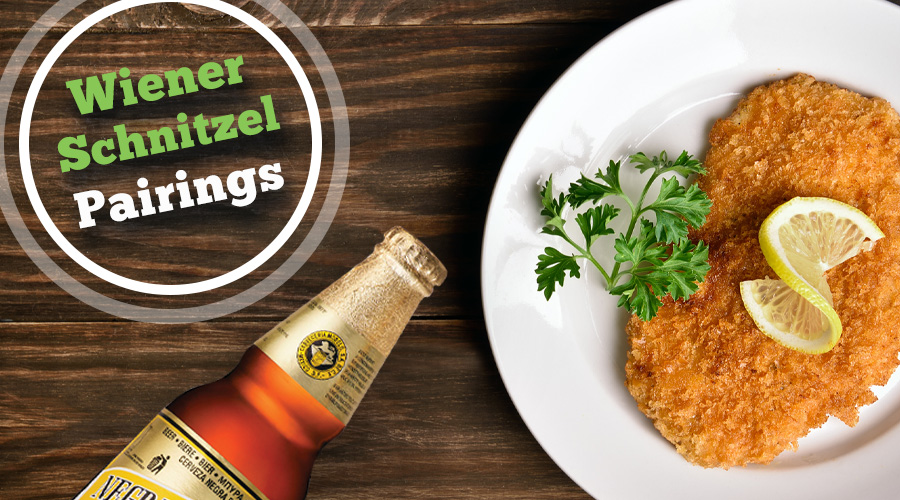
In honor of Oktoberfest starting at the end of the month, and also in honor of the perfect Austria dish, the wiener schnitzel, we’ll be pairing up beers with your bites!
But first, some background!
What Is Schnitzel?
Schnitzel is a cooking method. Pounding a piece of meat to tenderness and then lightly coating it in a flour, egg, and breadcrumb mixture before quickly pan-frying the whole thing is called “schnitzel.” Food historians debate the true origins of the method, but Austrians have claimed it as their own, making the dish something of a national treasure. Schnitzel can be found everywhere from high-end restaurants to street carts and, of course, at home.
Wiener schnitzel means veal. Authentic wiener schnitzel is the only schnitzel made with veal and is protected as such under Austrian law. German schnitzel (or Schweineschnitzel) is traditionally made with pork chops that are also thinly breaded and fried in a tender crisp coating.
So, be sure to do your schnitzel right and procure some fresh veal instead of pork! But what do you drink with such a specific dish?
Schnitzel Pairings
Harpoon Brewery’s UFO White is a light, crisp beer brewed in the style of traditional Belgian witbiers. Made with wheat and very lightly hopped, the beer is spiced with coriander and orange peels, giving it a nice citrus finish. This is a great beer for the warmer weather, and the citrus complements the lemon garnish of the Schnitzel perfectly.
You could also opt for a more traditional Austrian beer – Negra Modelo. Yep, a Mexican beer as the perfect complement to an Austrian dish. Fun fact: Negra Modelo is a Vienna Lager style beer, created by Austrian immigrants in Mexico in the 1800s. The beer features a prominent and clean malt backbone, derived from the Viennese and Munich grains used in the brewing process. There is just enough hop flavor to balance out the malt, and the beer as a whole has a complex nutty/toasty flavor.
Another excellent choice to pair with your wiener schnitzel is Hofbrau Oktoberfest, a full-bodied lager known for its clean, crisp edge. It’s also the official beer of Oktoberfest! With its fine hoppy aroma, it’s perfect alongside a classic wiener schnitzel.
If you’d like to make your own wiener schnitzel, check out our easy recipe below!
Wiener Schnitzel
Serves 4
- 4 veal top round cutlets/escalopes (or loin, topside, rump) 4-5 ounces each
- 3 eggs, lightly beaten with 3 tbsp. of cold water
1 cup all-purpose flour (coarse-grained flour works best) - 2 cups very fine breadcrumbs from Kaiser rolls, sifted (no panko!)
- Salt
- freshly finely ground white pepper (optional)
- 3 cups light vegetable oil like canola (or clarified butter) for frying
- for garnish
- 1 lemon cut into 4 wedges
- ½ cup parsley leaves, fried (optional)
- ¼ cup lingonberry or cranberry preserves (optional)
Instructions
- Pre-salting: If you didn’t buy kosher meat, you should salt the slices of meat and put them back into the fridge for two days. This step is not mandatory but will result in a dramatically tastier and juicier piece of meat!
- Pound the
cutlets: Put the meat in plastic
wrap or in a plastic bag to reduce the mess. Delicately flatten the cutlets
with a meat mallet or tenderizer. In a pinch, you can use a cleaver or the
bottom of a small skillet or saucepan. Try to get even thin cutlets, between ⅛-¼ inch thick. The latter is the gold standard in
Vienna. Too thin, it’ll dry out and you would end up with nothing but
breadcrumbs in your mouth, overpowering the meat. You may want to trim away any
ragged edges.
(Up to this point you can prepare ahead. Keep refrigerated wrapped in plastic for a maximum of 2 days.) - Heat the oil to 350°F. Traditionally, plenty of oil is required. At least 1 inch of oil in a heavy bottom skillet no less than 2 inches deep. (If the schnitzel can’t swim, it will be sautéed, which will result in uneven browning, the crust not puffing up, and the meat not cooking in its own steam casing.) Alternatively, use a deep fryer.
- Breading the
cutlets: Place 3 separate plates
side-by-side: One with the flour, one with the lightly beaten eggs and one with
the breadcrumbs. If you didn’t pre-salt the cutlets, season with salt. If
using, also season with freshly ground white pepper.
Take one cutlet and dredge it in the flour, shake off any excess, then dip the cutlet into the egg and finally into the breadcrumbs. Don’t press on the cutlets! This would prevent the crust from souffléing, from puffing up. Delicately shake off the excess breadcrumbs. Fry immediately. - Frying the
schnitzel: Check that the oil is
hot enough. The oil must sizzle when you place a schnitzel into it. Fry the
schnitzel until golden — or the color of a violin. Flip to brown the other
side. Don’t stop shaking the skillet in a circular motion to help to loosen the
crust and trap steam under the coating to puff it up. The oil swirling in waves
over the top of the cutlet also results in a much lighter crust.
If you are scared to spill oil, or if you are using a deep fryer, you should use a ladle to continuously spoon hot oil on top of the schnitzel to help it soufflé. - Dry the schnitzel: Take the schnitzel out of the skillet and let drip back into the pan as much oil as possible. Place the schnitzel on paper towels or a kitchen towel to absorb the grease. Place on a rack in a 200°F (100°C) oven, just the time to prepare the other three schnitzels, up to 10 minutes.
- Serve immediately on warmed plates with lemon wedges and optionally with fried parsley leaves and lingonberry jam. Never serve sauce with a Wiener schnitzel; it would ruin the crunch. Also, capers, anchovies, and eggs are unheard of on a Wiener schnitzel but are part of the à la Holstein or French à la Viennoise garnish.
Accompany the schnitzel with a classic, slightly tangy cucumber, beet or potato salad or, a leafy green salad like a baby gem lettuce or frisée. Sautéed or boiled new potatoes sprinkled with chopped parsley is another traditional pairing.




